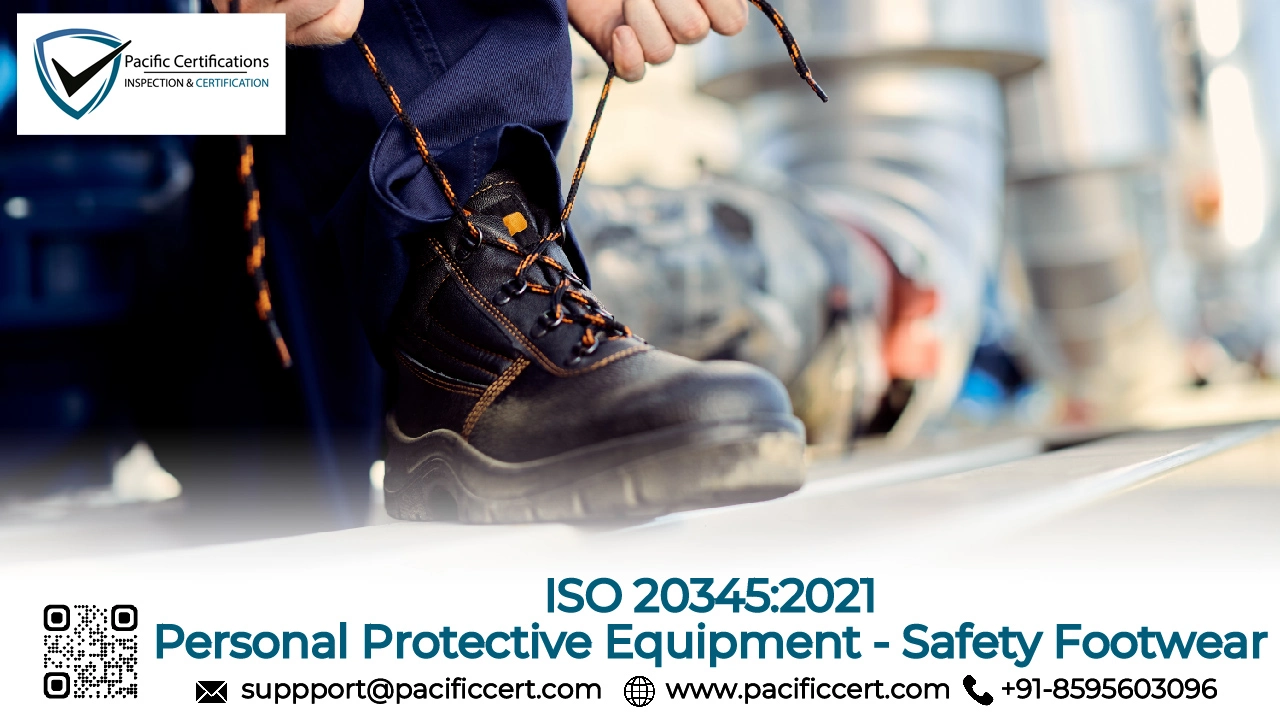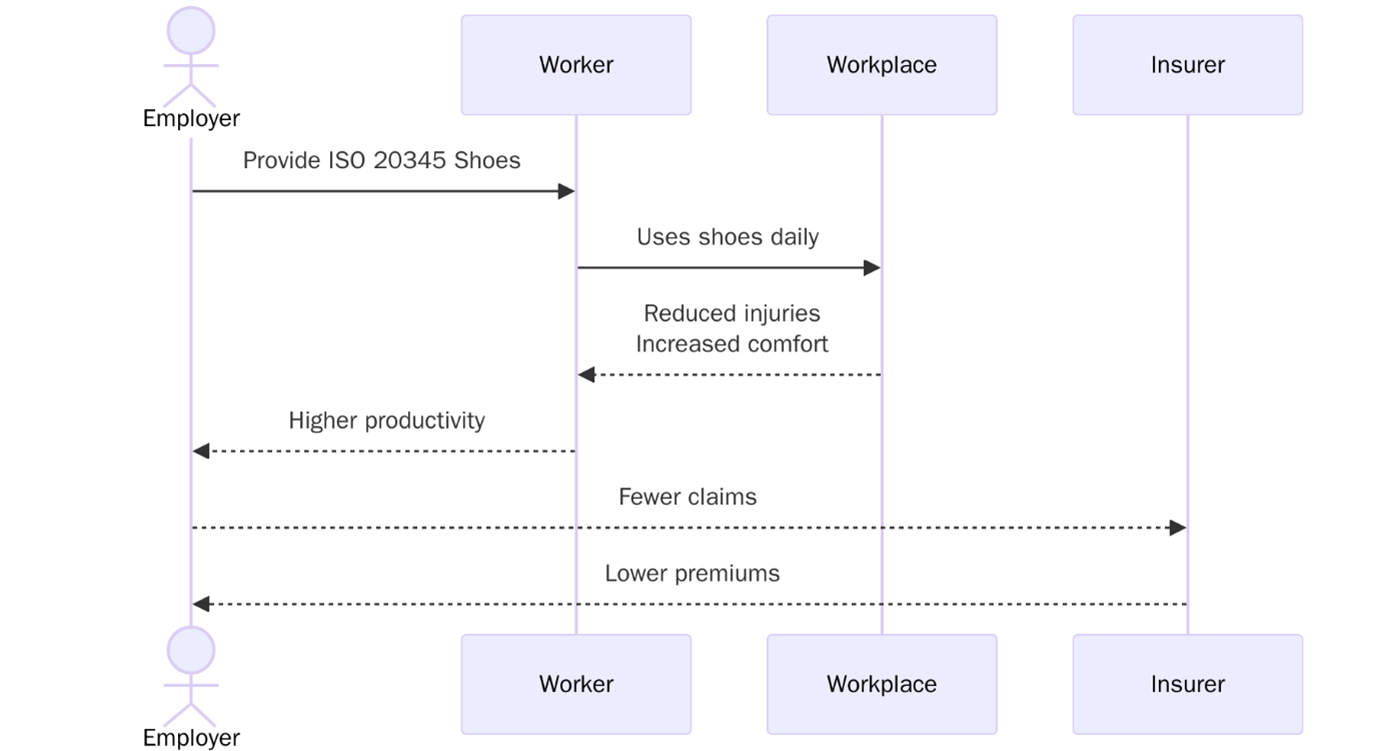What is EN ISO 20345?

ISO 20345:2021 is an international standard that specifies minimum requirements for safety footwear used in occupational settings where protection against injuries is necessary. It defines performance criteria for footwear equipped with safety toe caps and other features designed to shield the wearer from physical hazards such as impacts, compression, penetration, slippage and electrical risks.
This standard is widely adopted across industries such as construction, manufacturing, mining, logistics, and energy, where foot injuries are common. It is part of the broader ISO 20340 series that addresses various types of protective and occupational footwear.
If you are looking for ISO certification, contact us at support@pacificcert.com.
What is the purpose of EN ISO 20345?
The primary purpose of ISO 20345 is to ensure that safety footwear provides a consistent and reliable level of protection for workers exposed to a range of hazards in the workplace. The standard helps manufacturers and employers confirm that footwear meets globally recognized safety specifications.

It also supports workplace safety compliance and promotes user confidence in the protective capabilities of certified products.
If you are looking for ISO 20345 certification for your safety footwear, contact us at support@pacificcert.com.
What is the Scope and Applicability of EN ISO 20345?
ISO 20345 specifies the basic and additional requirements for occupational safety footwear that incorporates toe protection against a 200-joule impact and 15 kN compression. It also includes optional features like puncture resistance, anti-static properties, water penetration resistance, and cold insulation.
Applicability:
The standard applies to manufacturers, suppliers, and testing laboratories involved in:
- Safety boots and shoes production
- Construction and heavy industry PPE supply
- Warehouse and logistics safety equipment
- Oil & gas and mining protective gear
- Government procurement and defense contracts
- Certification bodies and test houses involved in CE marking and conformity assessment
If you are a safety footwear manufacturer or importer, contact us at support@pacificcert.com!
Key Definitions
- Safety Footwear: Footwear incorporating toe protection to protect against injury caused by falling objects or compression.
- SB (Safety Basic): The minimum safety category defined in ISO 20345 with basic toe protection and other core features.
- Penetration Resistance (P): Protection against sharp objects piercing the sole.
- ESD (Electrostatic Discharge): Footwear designed to dissipate electrostatic charges.
- Slip Resistance (SR): Footwear that provides grip on various surfaces, tested under wet and dry conditions.
EN ISO 20345 Clauses-wise Structure
Clause | Title | Overview |
1 | Scope | Describes the extent and limitations of the standard. |
2 | Normative References | Lists reference documents essential for the application of the standard. |
3 | Terms and Definitions | Provides definitions related to safety footwear and testing criteria. |
4 | Classification | Defines the footwear types based on construction and material (e.g., leather, polymer). |
5 | Basic and Additional Requirements | Details minimum safety requirements and optional features. |
6 | Marking | Specifies labeling requirements, such as pictograms and performance codes. |
7 | Information Supplied by the Manufacturer | Lists documentation and user guidance that must accompany certified footwear. |
What are the requirements of EN ISO 20345?
To comply with ISO 20345, manufacturers and distributors must:

- Use certified testing laboratories to assess footwear against mechanical, thermal, and chemical hazards.
- Ensure all mandatory components (toe caps) meet the impact and compression resistance requirements.
- Conduct tests for optional features like water resistance, antistatic properties, and puncture resistance if applicable.
- Apply the correct classification codes (SB, S1, S3, etc.) based on feature sets.
- Include user information with details on usage, limitations, and maintenance.
- Apply legible markings with symbols defined in ISO on each product.
If you are preparing for ISO testing and certification, contact us at support@pacificcert.com.
Documentation Required
- Technical file (construction materials, performance specs)
- Test reports from ISO/IEC 17025-accredited labs
- Risk assessment related to intended use environments
- Declarations of Conformity (DoC)
- Labels, markings, and pictograms for each product model
- Manufacturer’s usage instructions and warnings
- Internal quality control and inspection records
- CE marking documentation (if applicable in Europe)
If you need help organizing documentation for ISO 20345 certification, contact us at support@pacificcert.com.
Certification Timeline
Week | Activity | Description |
Week 1 | Application Submission & Pre-review | Submission of product technical file, safety features, materials, and initial documentation. Scope is confirmed and appropriate test requirements are outlined. |
Week 2 | Sample Preparation & Lab Coordination | Product samples are finalized and dispatched to an ISO/IEC 17025-accredited testing lab for evaluation under ISO 20345 parameters. |
Week 3 | Product Testing Phase (Continued) | Accredited lab performs tests for toe impact, compression resistance, penetration resistance, antistatic performance, water resistance, etc., depending on product features. |
Week 4 | Test Report Compilation & Technical Review | Lab submits formal reports. Certification body reviews results to verify product compliance with ISO 20345 mandatory and optional requirements. |
Week 5 | Factory Evaluation & Marking Review (if required) | Evaluation of production setup, internal quality control, consistency in markings, and documentation related to usage instructions and DoC (if CE marking required). |
Week 6 | Certification Decision & Certificate Issuance | Upon successful review, ISO 20345 certificate is issued. Certificate includes reference to tested models, scope, and applicable marking codes. |
If you are looking to certify your safety footwear under ISO 20345:2021, contact us at support@pacificcert.com.
What are the benefits of EN ISO 20345?
Lately, the global PPE footwear market continues to see growth driven by occupational safety mandates, ESG accountability, and worker wellbeing programs. Rising incidents of foot injuries, stricter labor laws, and increased infrastructure investment in Asia-Pacific and North America are fueling demand for certified safety footwear. Below are the key benefits:

- Guarantees defense against common workplace foot injuries.
- Aligns with national and international PPE laws and import/export regulations.
- Facilitates CE marking and global distribution of certified footwear.
- Demonstrates adherence to high safety standards and tested performance.
- Lowers risk of worker injury claims and enhances occupational health & safety (OH&S).
- Helps manufacturers stand out in competitive PPE markets.
- Often required in government and defense procurement contracts.
- Promotes structured product testing, inspection, and continuous improvement
There’s also a surge in interest for eco-friendly and ergonomic safety shoes, with ISO 20345 being integrated into sustainability and quality procurement frameworks. Digital testing, RFID-enabled tracking and the use of nanomaterials are reshaping how safety footwear is manufactured and assessed.
If you are entering global markets and need ISO 20345 product certification, contact us at support@pacificcert.com!
How Pacific Certifications Can Help?
As an ABIS-accredited certification body, Pacific Certifications offers independent, third-party EN ISO 20345 product certification services that ensure your safety footwear complies with all mandatory and optional performance criteria.
We offer:
- Product file and document review
- Coordination with ISO/IEC 17025 accredited testing labs
- Product assessment and marking verification
- Certification issuance for international trade
- Surveillance services to maintain compliance
- CE marking assistance under PPE Regulation (EU) 2016/425 (if required)
If you are looking for ISO 20345 certification, contact us at support@pacificcert.com
FAQs: ISO 20345
Is ISO 20345 certification mandatory?
It is not mandatory globally, but many employers, regulators, and buyers require it to ensure safety compliance and market access.
What’s the difference between SB, S1, and S3 footwear in ISO 20345?
- SB: Basic safety (toe protection)
- S1: Adds anti-static sole, energy absorption, and closed heel
- S3: S1 features + water resistance and penetration-resistant sole
Can ISO 20345-certified footwear also meet CE marking requirements?
Yes, if tested and certified by a Notified Body, ISO 20345 footwear can carry the CE mark under the EU PPE Regulation.
How long is the certification valid?
ISO 20345 certification is valid as long as the product design and test results remain unchanged. Surveillance or retesting may be required periodically.
Who can issue ISO 20345 certification?
Only recognized and accredited certification bodies such as Pacific Certifications can perform independent certification assessments.
What is ISO 20345?
It’s the international safety-footwear standard that sets the basic and optional requirements (e.g., 200 J toe-cap impact, slip and thermal performance) for boots and shoes used at work. EN ISO 20345:2022 is the latest European/International update of this standard
What’s the difference between S1 and S3 safety shoes?
S3 covers everything in S1 and adds a penetration-resistant midsole and water-resistant upper—better for construction and outdoor, damp, or debris-strewn sites
How does EN ISO 20345 differ from ISO 20347?
20345 is “safety footwear” with a protective toe cap (200 J). 20347 is “occupational footwear” for lower-risk environments and has no mandatory toe cap. Choose 20345 where impact/crush hazards exist.
Ready to get EN ISO 20345 certified?
Contact Pacific Certifications to begin your certification journey today!
Suggested Certifications –
Read more: Pacific Blogs







